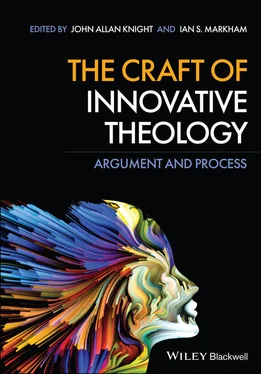The middle section is where you make your argument. In general, we find it helpful if each step in your argument has its own section. The sections may or may not have a title (i.e. the sections may just be numbered); the journal you pick may have guidelines for this.
Not all arguments rely on textual evidence (a purely logical or a priori argument won’t), but even those that don’t will likely involve some text that you are disputing. If your argument involves textual evidence, you’ll need to do more than simply quote the texts. You will need to interpret them. This will require several steps. First, either simply quote the text or re‐state in a summary fashion what the author is saying. Next, if there are ambiguities, state the various meanings that the text might have, then specify which meaning is most supportive of your argument. Then show how, in the context of the entire text, this meaning is the best one. You can do this by noting a contradiction or an adverse logical ramification to the alternate meanings. Finally, explain exactly how the text in question supports your argument.
On the other hand, if you are criticizing a text, state the various meanings that the text might have, then specify which meaning is most resistant to your critique. Then you have two alternatives. First, you can show that this is the only meaning that can withstand your critique. Second, you can show that even this most resistant meaning cannot withstand your critique.
You will also need to consider and refute counterarguments. If there are counterarguments in the literature, you need to find them and argue against them. And if there are other possible counterarguments that have not yet been raised, you’ll need to articulate them and refute them as well.
Your conclusion should include three elements. First, summarize concisely the findings of your essay, including the thesis. Second, without trivializing your essay, specify the limitations of your argument. Claiming to have done more than you actually have will reduce your credibility. Third, explain your original contribution. How has your essay done something that other publications have not? Finally, propose possibilities for future work, describing how such possibilities have been made possible by the work your essay has accomplished.
Now that we’ve mentioned some of the basic elements of a publishable essay, let’s talk about the process of writing it.
The first thing to do, of course is research and read. Read a lot. Make notes on the reading. Make sure your research is current and complete. As you’re reading, think about the way you will explain to the reader how your essay relates to work that has already been published. It’s not necessary to mention every previous publication on your topic, but situating your essay in the context of previous work in the field is necessary to demonstrating your specific contribution. In addition, as you’re reading and doing research, think about how to formulate the question your essay will answer. As you’re considering various formulations, remember the elements of a good question as we discussed earlier. It is not uncommon to begin with an overly broad question and, as you read more, narrow the question down until finally it is narrow enough to be answerable within the space of an article‐length essay.
First, submit your essay to only ONE journal at a time. Often, authors write the essay first and then decide on a journal. The process will probably be faster and easier, however, if you decide on the journal first. The problem of writing the article first and then deciding on the journal latter is that the guidelines of each journal varies significantly. Hours can be wasted as you change the citation system and delete pages of text that exceed their word limit.
Know the audience and the most common topics of the journal. The best way to do this, in addition to reading the description on their web site, is to read several articles from the journal to get a sense of the kinds of discussions they publish. If your preferred journal is published in the UK and has primarily British readers, you should not assume, for example, that they all know the American system (and similarly for British writers publishing in the US). You can ask your advisor to recommend a couple of journals. Look at the journal’s web site for submission guidelines (citation style, word limit, etc.), and follow them carefully as you’re writing. This will not only save you time but will also avoid irritating the editors right out of the box.
In addition, note that journals have a specific identity. Religious Studies , for example, focuses on philosophy of religion; submitting an essay to that journal discussing the relationship between Canaanite and Israelite religion would be pointless. Theology Today , while it publishes scholarly articles, also publishes essays pitched to a broader readership than practicing scholars. So it’s helpful to decide on the audience to which you wish to speak and pick your journal accordingly. This may seem obvious, but we hear from editors that it is surprising how many essays are submitted to journals whose focus has almost nothing to do with the essay.
Finally, think about how quickly you want your work to be published. Some journals are more prestigious than others and have a higher rate of rejection. In addition, some journals are known for their lengthy wait before publication. We have had articles accepted as is, but it took two years after acceptance until the articles appeared in print. Some journals with lengthy wait times will publish your essay online while it is waiting; listing the “doi” number on your cv will show prospective employers that your work is publishable.
Formulate a Good Question
Remember the elements of a good question we discussed earlier. Your essay will be an answer to the question you have formulated. Confine your paper to answering that question. The strongest papers answer one question convincingly, provide plenty of evidence and arguments to support the answer, and position the argument within the overall conversation in the field. This will often mean that you cannot publish a whole dissertation chapter in a journal article. Instead, you may need to take one argument or sub‐argument from the chapter and resituate it into a contemporary conversation in the literature.
The structure of your paper is as important as the content. Structure your outline so that it’s as easy as possible for a reader to follow your argument from beginning to end. Every good essay follows a strong narrative arc, and this should be displayed in your outline. This narrative arc can be a logical or historical progression, and it will constitute the structure of your argument. We like to have an outline in mind before we start writing. Others like to start writing and get inspiration and ideas before they start writing. However you begin, a good essay will follow a well‐structured outline.
Make sure to explain clearly how your work is an original contribution. Even if your essay is an interpretation of an aspect of another scholar’s work, or a reinterpretation of a theological concept, you must still have something original to say in order for the piece to be publishable. This contextualization is crucial and is a common reason for rejection of articles after peer review. Don’t be bashful when you write. Make sure your paper demonstrates a strong authorial voice that is neither unduly modest nor overconfident. Above all, seek clarity. Writing that is clear and easy to read is also easier to understand and more persuasive. Keep in mind that clarity does not equate to superficiality, and clear writing does not necessarily involve overgeneralizations. Generally speaking, language that is more specific is clearer and less conducive to misunderstanding.
Читать дальше











